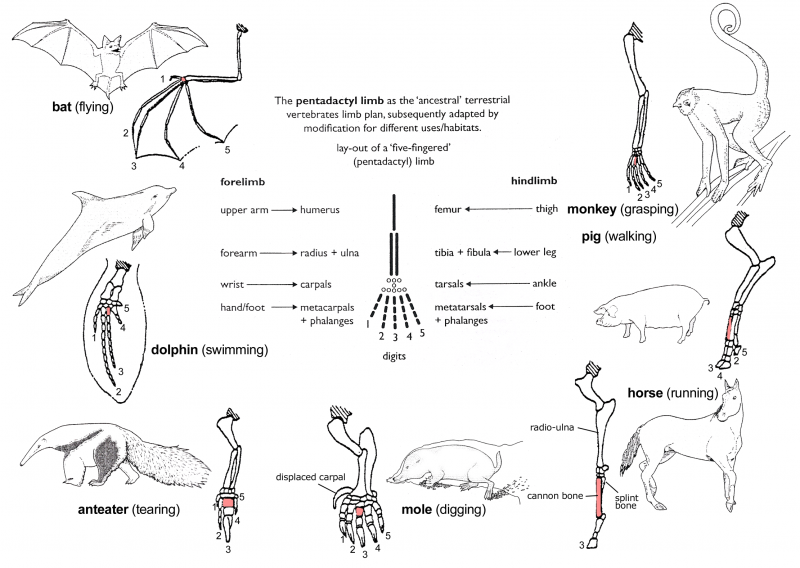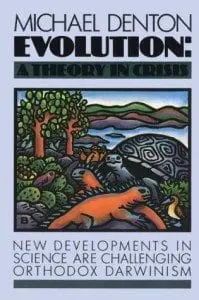If I was limited to recommending reading one, and only one, book about evolution among all the hundreds (or possibly thousands) of books on the subject published over the last 150 years, I would recommend Evolution: A Theory in Crisis by Michael Denton. Evolution: A Theory in Crisis is a virtual tour-de-force, a juggernaut, and unquestionably a superb masterpiece of scientific polemics.
Aside from the sheer power of Denton’s internal argumentation, Denton is an agnostic and has the advantage of being immune from being accused of being a Bible-thumping, young-earth creationist. Not only is Denton an agnostic, he is an evolutionist. He’s pretty careful not to indulge in advocacy, but to judge from certain remarks he has made he appears to lean towards punctuated equilibrium or some form of vitalism, or a combination of the two, as an evolutionary model. Moreover, he made the remark somewhere that “evolution always hits her mark.” Clearly, such a statement eliminates the idea of random mutation and natural selection as driving forces of evolution. Denton may be an evolutionist but he is clearly not a Darwinist. Moreover, Denton is not an advocate of a young earth. He accepts the old-earth theory of the uniformitarians apparently without dispute (and apparently without scrutiny).
The heart and soul of Darwinian evolutionary argumentation is its’ deep taproot in comparative anatomy, specifically homology, that is to say the similarity in body plan of various living creatures, the pentadactyl (five digit) design of the mammalian limb being the classic example. Denton comments:
“Since 1859 the phenomenon of homology has been traditionally cited by evolutionary biologists as providing one of the most powerful lines of evidence for the concept of organic evolution.”—pg. 143.
Upon superficial consideration the evolutionists have at least a plausible argument here. The pentadactyl (five digit) design of the human hand is, indeed, strikingly similar to the design of the limbs of many animals. Evolutionists have taken this fact and ran with it. Of course a plausible argument is not necessarily a correct argument. If I were to find a dead man sprawled out on the ground with a large hole in his chest, it would be plausible that he was struck dead by a meteorite. That is a plausible hypothesis. But a plausible hypothesis is not necessarily a correct hypothesis nor even the most likely hypothesis when all the facts are brought to bear on the subject.
To get a clear sense of the significance of this subject, Denton quotes Darwin at length. Here is a portion of Darwin’s comments:
“We have seen that the members of the same class, independently of their habits of life, resemble each other in the general plan of their organization….What can be more curious than that the hand of a man, formed for grasping, that of a mole for digging, the leg of the horse, the paddle of the porpoise, and the wing of a bat should all be constructed on the same pattern, and should include similar bones, in the same relative positions?…the kangaroo…koala…bandicoots…Australian marsupials…
“Professor Flower, from whom the statements are taken, remarks in conclusion, ‘We may call this conformity of type, without getting much nearer to an explanation of the phenomenon,’ and he then adds, ‘but is it not powerfully suggestive of true relationship, of inheritance from a common ancestor?’”—pg. 143, Evolution: A Theory in Crisis, quoted from “The Origin of Species by Means of Natural Selection Or the Preservation of Favored Races in the Struggle for Life,” 6th ed, 1962, Collier Books, pp 434-435
As I said above, this is the heart and soul, or the bottom line, if you will, of Darwinism. What the Darwinists had going against them in paleontology (the absence of intermediates in the fossil record) and animal husbandry (the empirical limits to variability within species), and biology (the impossibility of random processes producing multiple coordinated mutations) they seemed to possess in homology. But even at this level of knowledge and logical inference, ought it not to have been obvious to Darwin that if common descent were true then ALL of the fields of science would have dovetailed to corroborate the thesis? So even with homology suggesting evidence of possible common descent, homology would not be enough by itself. This is why I have asserted elsewhere that Darwin’s evolutionary assertions were specious even in his own time. Moreover, homology, even considered standing alone, is both a kind of two-edged sword and Trojan horse. What looked like a gift to evolutionists had a vast genetic horde of anti-evolution soldiers hiding inside. Denton observes:
“The same deep homologous resemblance which serves to link all the members of one class together into a natural group also serves to distinguish that class unambiguously from all other classes.”—pg. 155
The deep divisions between classes of living organisms, which are comparable to light years of astronomical distances between galaxies, are just as striking as the similarities, and the similarities are just as equally attributable to intelligent design as they are to common ancestry. There is no way to empirically validate the one over the other without corroborative evidence. Evidence from embryology or genetics might have bolstered evolutionary theory to some degree but even if these fields of knowledge had turned out as evolutionists had hoped, this still would not have been decisive for evolution. Favorable evidence of homology in embryology and/or genetics could not have disproved intelligent design, but contradictory evidence to evolution via non-homology in embryology and genetics can (and, in my view, does) falsify evolutionary theory. Evolutionary theory requires homology at the genetic and embryological level. If it is not there, natural evolution is empirically and demonstrably false. Denton quotes Sir Alister Hardy to this effect:
“The concept of homology is absolutely fundamental to what we are talking about when we speak of evolution—yet in truth we cannot explain it at all in terms of present day biological theory.”—pg. 151
And Denton notes himself:
“Clearly, such a trend carried to the extreme would hold calamitous consequences for evolution, as homologous resemblance is the very raison d’etre of evolution theory.”—pg. 154
Darwin and evolutionists after him had confidently expected that the study of embryology and the study of genetics would bolster evolutionary claims but this hope has been resoundingly dashed in pieces. The march of scientific progress in these fields has been very, very unfriendly to evolutionary claims, to understate the case.
Denton comments:
“Homologous structures are often specified by non-homologous genetic systems and the concept of homology can seldom be extended back into embryology. The failure to find a genetic and embryological basis for homology was discussed by Sir Gavin de Beer, British embryologist and past Director of the British Museum of Natural History, in a succinct monograph Homology, an Unresolved Problem.”—pg. 145, emphasis supplied
And,
“ It appears that Darwin’s usage of the term ‘homology,’ which he defines in the Origin as ‘that relationship between parts which results from their development from corresponding embryonic parts’ is, as De Beer emphasizes, just what homology is not.
“The evolutionary basis of homology is perhaps even more severely damaged by the discovery that apparently homologous structures are specified by quite different genes in different species.”—pg. 149
And:
“Over and over again, as knowledge of invertebrate zoology has increased over the past two centuries, structures of astonishing similarity which were first thought to be homologous were later found to be only analogous. In botany, too, homologous resemblance has often had to be later reclassified as convergence, or analogy.”—pg. 153
The collapse of homology as support for evolutionary claims also powerfully spotlights the order we see in nature via homology as being the imposition of mental or conceptual classifications upon the material biological world, in other words, an imposed order according to a plan. THIS IS DIRECT AND COMPELLING EVIDENCE OF INTELLIGENT DESIGN!
In my next article, “THE ADEQUACY OF THE FOSSIL RECORD,” we will highlight the falsehood of Charles Darwin’s claim about “the extreme imperfection of the fossil record,” and show that the fossil record is, in fact, substantially complete.








